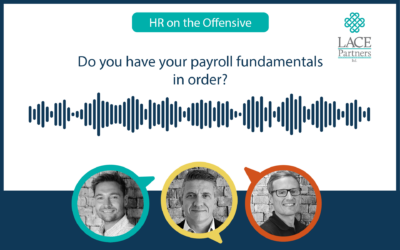In a recent HR on the Offensive podcast Cathy and Chris from LACE Partners sat down (virtually) with Paul Griffin, Head of Employment at Norton Rose Fulbright, to talk about some of the challenges HR teams are facing from a legal perspective as organisations return back to their workplaces. In this blog – part one of two and following our recent podcast – we look at some of the key discussion points surrounding the duty of care employers have with their employees. With questions asked such as “what are ‘rules’ and what are ‘guidelines’ from government?” and “What happens to those people with childcare arrangements that are concerned with going back to work?”
With more and more businesses making tentative steps towards integrating their employees back into various workplaces, HR teams across the UK are asking the question around what their duty of care is to their people. But with so many varied opinions of where the boundaries are and what the practicalities are, it is important to get an effective definition. From a legal perspective when you look at duty of care you need to take into account the common law; this is judge-made law which is built up over a number of years through cases. The second consideration is the Health and Safety at Work Act, which is backed up by a series of regulations dealing with reporting and the mechanics around health and safety.
Both of these elements have a common theme – as an employer you need to do everything in your power to protect the safety of your employees that is practicable. The Covid-19 situation – like any in the workplace – has to be managed through the lens of this legislation and the common law duty. The duties are going to be undertaken by completing risk assessments which then lead to implementing a safe system of work. This means looking at elements such as social distancing, PPE for employees, and ventilation, as well as potentially reducing staff numbers or visitors. Businesses that might get a lot of deliveries, for example, may need to conduct an assessment as to how you can make the process for receiving those deliveries contactless.
Enforcement is a key element of compliance and as an employer you must be seen to be enforcing the rules that you have laid down through surveillance, disciplinary action and management of grievances. But the government was quite prescriptive and rapid in its implementation of lockdown.
So how much of the new ways of working are ‘rules’ and how much are ‘guidelines’?
The government have issued specific Covid-19 guidance based on eight workplace scenarios (you can find out more about that here) but these are not laws and have not been the subject of any legislative process. Nevertheless, the government advice and guidance is going to be essential for employers in demonstrating compliance in dealing with these risks. The situation between March and now has been a rapidly moving one, so whilst these guidelines are not laws they will be important. There are also other channels through which employers can look for advice. ACAS, or the ICO, for example, all provide resources and guidance on issues that will arise from the Covid-19 global pandemic, so it is important to ensure you are referencing these sources when you make any decisions.
Being able to evidence that you have used these sources, as well as documenting your processes when undertaking your risk assessments is key. You need to be able to show that you have done absolutely everything in your power to mitigate the risk and by referencing these sources you are showing that you are being fastidious in your approach to the health and safety of your workers in the workplace. If you have more than 50 employees you need to publish this information in writing on your website anyway, so record-keeping is essential.
But what happens if the worst-case scenario occurs, one of your employees contracts the virus and they make the claim that it was in the workplace?
Unfortunately there is always an element of exposure that will exist, but managing risk will be important, so consult with employees about what they feel comfortable with in terms of working conditions and the rules you put in place. That communication, coupled with the documentation of the rules and practices, mean that employees who do not abide by the instructions you set out will enable you to conduct disciplinary proceedings against an employee on the basis of their failure to follow a lawful and reasonable instruction by the employer. But you must make it clear in any new policies that there will be disciplinary sanctions against any individual not complying with the rules you put in place. Countless disciplinary cases of unfair dismissal have been lost because the employer has failed to make it clear in their own policies that summary dismissal is a potential outcome.
Whether dismissal is appropriate will of course depend on the circumstances. Adding an additional person in the canteen by one, for example, or not declaring a high temperature, are at either ends of the spectrum!
Grievances from employees is another area in which there may be an increase, as individuals feel that some colleagues are perhaps not following the guidelines and it puts their own health at risk. As has already been mentioned, from an employers’ perspective it will be important to ensure that you are making it very clear what those rules are, making them easily accessible – e.g. visible easily via the company intranet, or webinar briefings internally for staff – will be critical. Something as simple as a defunct link on an intranet can cause you to have problems so ensure that you have all of your communications channels up to date.
What about the journey to and from work? Or if you are in a shared building with other businesses? How far does the duty of care requirement stretch?
Most of your duties will of course relate to the workplace itself; the physical building in which you expect your employees to work. For some employees that travel around the country, however, the implications are wider. Under the Employment Rights Act there are also protections available where an employee perceives imminent and serious danger. If, in response to that, they suffer dismissal or a detriment by the employer, then they can claim compensation for the detriment or dismissal. The government has said “avoid public transport where possible” and the relevance here is whether the employee can travel via a train or other public transport, which is rather ambiguous from a legal standpoint; as we’ve said a few times already in this piece the importance of communicating with the employee, understanding their circumstances and acting accordingly with their health and safety in mind will stand you in good stead.
If you would like to find out more about your duty of care, or if you would like to talk to the team at Norton Rose Fulbright about your specific circumstances, get in touch with Paul via LinkedIn, or reach out to him at Paul.Griffin@nortonrosefulbright.com.






